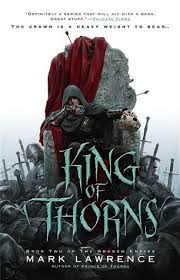
2‑King of Thorns
Chapter 1: Prologue
by Mark, Lawrence,The prologue of *King of Thorns* opens with the narrator discovering scattered, charred pages carried by the wind across a desolate landscape. These fragile remnants, barely held together, seem to hold a story that feels intimately connected to him, though they belong to Katherine—his aunt and the object of his longing for years. The imagery of snowflakes skittering across the pages underscores the bleak, cold setting, while the narrator’s urgency to collect them hints at their significance to his own unresolved emotions and memories.
Sitting atop the ruins of his destroyed castle, the narrator reflects on the aftermath of a brutal siege, surrounded by the dead and the remnants of war. The towering mountains dwarf the scene, emphasizing the insignificance of human conflict in the face of nature’s grandeur. Despite the chilling wind and the acrid smoke from fires, he immerses himself in Katherine’s fragmented memories, suggesting a deeper quest for understanding or closure amidst the physical and emotional devastation.
Katherine’s presence looms large in the narrator’s life, not just as a familial figure but as an obsession that haunts his dreams. Her story, though incomplete, becomes a lens through which he views his own past and desires. The contrast between the ephemeral pages and the weight of his fixation on her highlights the tension between memory and reality, as well as the fleeting nature of human connections in a world marked by violence and loss.
The prologue sets a tone of melancholy and introspection, blending the narrator’s personal turmoil with the stark, war-torn setting. The act of reading Katherine’s memories amidst the ruins symbolizes a search for meaning in the aftermath of destruction. The chapter establishes key themes of longing, memory, and the enduring impact of the past, while foreshadowing the emotional and physical trials that lie ahead in the narrative.
FAQs
1. Comprehension Question
What is the significance of the scattered pages the narrator finds, and whose story do they tell?
Answer:
The scattered pages the narrator discovers are fragments of a written account, some damaged beyond recognition, while others remain partially intact. These pages belong to Katherine, the narrator’s aunt and sister to his stepmother. The narrator reveals a deep, unresolved longing for Katherine, stating he has “wanted her every moment of the past four years.” The pages contain her memories, which he reads amidst the ruins of his castle, suggesting they hold personal and emotional weight for him. This moment underscores the theme of fragmented history and unresolved desire in the narrative.2. Analytical Question
How does the setting—the ruined castle and surrounding mountains—contribute to the tone and themes of the prologue?
Answer:
The setting of the prologue—a destroyed castle surrounded by towering mountains—creates a tone of desolation and insignificance. The narrator sits among the dead and the wreckage of siege engines, emphasizing loss and futility. The mountains dwarf the scene, making the Haunt and the siege engines seem like “toys,” which reflects the narrator’s possible feelings of powerlessness or the transient nature of human endeavors. The cold, smoky environment, with snowflakes that “skitter” without sticking, further reinforces a sense of bleakness and impermanence, mirroring the fragmented nature of Katherine’s story.3. Critical Thinking Question
Why might the narrator chase after Katherine’s story despite the physical and emotional obstacles?
Answer:
The narrator’s pursuit of Katherine’s story, despite its damaged state and the harsh conditions, suggests an obsessive need to understand or reclaim something lost. His admission that he has longed for her for years implies unresolved emotions—whether love, guilt, or curiosity. By reading her memories amid ruins, he may be seeking closure, answers, or a connection to his past. The act of chasing the pages “as if it were my story” hints at blurred identities or shared histories, raising questions about ownership of narrative and memory in the broader story.4. Application Question
How might the imagery of fire, wind, and cold in the prologue symbolize the narrator’s emotional state?
Answer:
The imagery of fire, wind, and cold reflects the narrator’s inner turmoil and emotional extremes. The “smoke-wreathed ruins” and stinging eyes suggest destruction and pain, while the wind’s chill reaching “deep as bones” conveys a penetrating, unshakable sorrow or numbness. The snowflakes that are “too cold to stick” might symbolize fleeting or unfulfilled desires—much like his unresolved feelings for Katherine. Together, these elements paint a portrait of a man haunted by loss, surrounded by reminders of impermanence, and struggling with emotions that are as harsh and unrelenting as the environment.
Quotes
1. “I found these pages scattered, teased across the rocks by a fitful wind. Some were too charred to show their words, others fell apart in my hands. I chased them though, as if it were my story they told and not hers.”
This opening quote establishes the protagonist’s obsessive connection to Katherine’s story, portraying his desperate attempt to reclaim fragmented memories despite their physical decay. It sets the tone for the chapter’s themes of loss, memory, and personal obsession.
2. “Katherine’s story, Aunt Katherine, sister to my stepmother, Katherine who I have wanted every moment of the past four years, Katherine who picks strange paths through my dreams.”
This repetitive, almost incantatory quote reveals the depth of the narrator’s fixation on Katherine, blending familial ties with intense longing. It shows how she haunts both his waking life and subconscious.
3. “I sat upon the smoke-wreathed ruins of my castle, careless of the heaped and stinking dead. The mountains, rising on all sides, made us tiny, made toys of the Haunt and the siege engines strewn about it, their purpose spent.”
This vivid imagery contrasts personal tragedy with cosmic indifference, showing the narrator’s desensitization to destruction while emphasizing the insignificance of human struggles against nature’s scale. It captures the chapter’s post-apocalyptic atmosphere.
